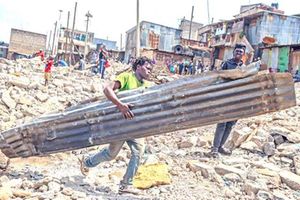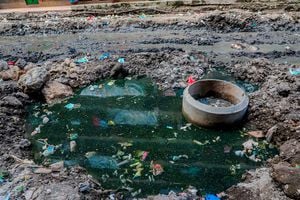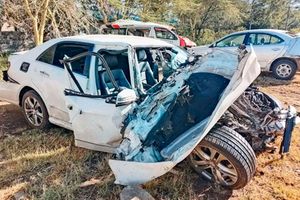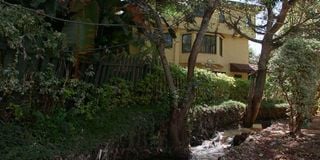
A canalized section of Kibagare River in a residential compound within Jade Valley estate.
More than six years since the National Environment Management Authority (Nema) brought down the Ukay branch of Nakumatt supermarket for straddling across a riparian reserve, the Kibagare River is in the news once again.
This time it’s upstream in Grevillea Grove, next to Kyuna estate, where the multi-billion Jade Valley villas are located. The 39, three-bedroom palatial homes go for a cool Sh50 million each. They can also be leased out for between Sh250,000 to Sh270,000 a month.
The high-end estate was thrust into the news last November when a heavy storm hit Nairobi and its environs, bringing down a perimeter wall and flooding several villas, contaminating the swimming pool, ruining the clubhouse and leaving the tennis court in a state of disrepair.
The flooding brought into sharp focus the contradiction of the May 2024 demolitions in Mathare area, ostensibly to reclaim the riparian land along the Nairobi River.
In bringing down the structures in the slum areas, the State said buildings and structures within the 30-metre riparian corridor were prohibited by law as they clog the rivers and expose dwellers on riparian reserves to grave danger of loss of life and property.
The Kibagare River is one of the tributaries that make the Nairobi River, and is part of the massive rehabilitation that the government through the Nairobi Rivers Commission is undertaking. Other tributaries include Gitathuru, Ruiruaka, Mbagathi, Kamiti, Kasarani, Mutuari and Riara.
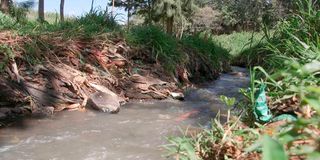
Kibagare River at the crossing bridge between Loresho and Kyuna estates.
This was not the first time floods were causing havoc at the Jade Valley villas, which are mainly leased out to employees of UNEP, the United Nations environment body headquartered in Kenya.
In 2017, Nema sued the villas’ owners, Sky Africa Holdings Limited, for among other breaches having constructed the property on riparian land, canalising the Kibagare River within its property and constructing boundary walls on the river.
The environmental management body further accused the villas’ owners of deliberately diverting the course of the Kibagare River to pave the way for the developments within its premises to the detriment of the environment, other users and public utilities.
UNEP, which champions environmental conversation, refused to be drawn into the debate. The UN agency said it has no control over where its employees seek accommodation across the city. The organisation also steered clear of the ensuing discussions about riparian land, declining to respond to all our questions and referring us to the Nairobi Rivers Commission.
Two directors of Sky Africa confirmed that the villas had been hit by similar floods about seven years ago, but denied accusations that the property sits on the river and that they had canalised the section running through their property.
“This is the second time it has happened and we attribute it to an act of God,” said the directors Yogesh Kanji and Azim Jamal.
Days after the flooding that left families devastated, the aftermath of the damage was quite evident. An L-shaped wall at the exit of the river had been brought down, and in its place was a temporary iron-sheets fence. Similarly, the perimeter wall next to the tennis court had some sections brought down by the violent waters.
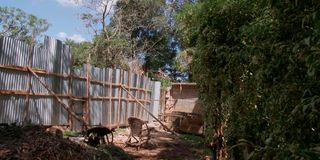
The mabati fence on the L-shaped wall that came down on November 24, 2024.
Kanji and Jamal blamed the storm waters that hit the villas on November 24, 2024, and were captured on social media. Images and videos shared online showed one of the residents literally marooned in his house as the raging floods brought down the perimeter wall around the property.
Attempts to get his young family out of the house were thwarted by the waters, which kept rising every minute as the river violently raged through the villas’ compound.
Before hitting the houses at the lowest end of the compound, the waters from the Kibagare River had run through the tennis court, poured into the swimming pool completely sweeping all the debris it had collected on its way and clogged the laundry room at the Jade Valley villas.
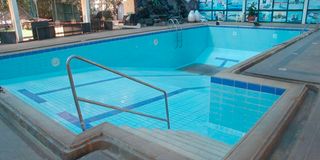
A drained swimming pool that was contaminated by Kibagare River waters as it swept downstream.
As if that was not enough, the storm ripped through the L-shaped perimeter wall that to date has not been reconstructed.
A visit to Jade Valley villas is testimony to the tragedy. Massive culverts pour water from Loresho side of the river into a tiny part of the Kibagare River and pass right in the middle of Jade Valley villas.
The villas are below the Red Hill Link Road that connects the Village Market to ABC Place along the Waiyaki Way. Looking below from this road, massive culverts below this road empty into a narrow channel.
“This is the artificial dam caused by the walls put up by the Sky Africa holdings”, says a resident of Jade Valley who sought anonymity for fear of victimisation by the property owners.
He was making reference to part of the wall that came down and the neighbouring properties.
“From here you can clearly see that the river (Kibagare) has been funneled so that it runs through a smaller inlet. This is what burst on the night of November 24, 2024”, the resident who works for UNEP told the Nation.
Unknown to the resident, Sky Africa Holdings had in October 2018, through consent 209 of 2017 at the National Environment Tribunal, agreed to remove the concrete wall erected across Kibagare River on LR 22842 Nairobi within sixty days of the date of the Consent.
Jade Valley owners, who were the appellants in the case, also agreed that they would subject the canal/waterway on its premises to a hydrological study for the purposes of determining its water flow carrying capacity within thirty days of the date of the consent.
However, by the time the judgement by the tribunal was made on June 12, 2021 nothing had happened. The result was the storm waters from the river bringing down these same walls on the night of November 24, 2024, to the chagrin of the villa owners and the residents.
The consent also stated that Sky Africa Holdings would prepare and submit an Environmental Audit (EA) with respect to its entire property and with emphasis on the sewer line and riparian reserve within thirty days.
But the two directors who spoke to Nation said this consent has been overtaken by events as the tribunal had dismissed assertions by Nema that they had canalised the river and also the charge that the property sits on riparian land.
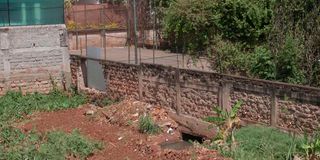
Kibagare River at the entry to Jade Valley villas.
“We have not interfered with the river (Kibagare) as it is still in its natural state and it has not been canalized,” said Kanji, who is the chairman of the holding entity for Jade Valley villas.
But he was at pains to explain how the storm waters could have caused so much havoc unless their property was constructed on riparian land.
We traced the source of Kibagare River at Kangemi Dam, about six kilometres from the villas. We could not get anyone to give us the history of the dam, but our observation was that its banks were slowly turning into a slum, with mabati houses dotting one side.
On the opposite side of the dam, we found people taking a bath, while others were washing their clothes. There is also a thriving irrigated vegetable farming for sukumawiki and spinach.
John Mwangi, whom we found drying out his clothes, said the dam was a good source of clean water that he uses to wash his clothes.
“If you look across, you’ll see people drawing the water for domestic purposes including cleaning and even cooking,” Mwangi says as he points to the mabati structures not far from Waiyaki Way along the Kangemi-Uthiru road.
The dam is not fenced and, according to locals, it has lately become a site for those who want to commit suicide by drowning. Three young boys we met confirmed that at least three bodies were fished from the dam last year.
“But we enjoy swimming here”, one boy aged 14 told us when we enquired if they had just finished swimming. He, however, warned us that the dam is deep and could cause death if one is not an adept swimmer.
From the Kangemi dam, Kibagare River emerges after the Lions Eye Hospital in Loresho. It then flows past Kibagare slum. Here, the water is used to grow vegetables, maize and arrowroots.
At this point, the water is fairly clean but is slowly gathering debris. It runs parallel to the affluent neighbourhood till it emerges below the Red Hill Link road and finds itself channelled into a tiny duct into Jade Valley villas compound for about 20 metres,
before it re-emerges.
It flows past the Spring Valley area towards Westgate Mall, onto the former Nakumatt Ukay Supermarket, into Parklands area, to City Park and into Pangani, eventually Connecting to the Nairobi River in Mathare slums.
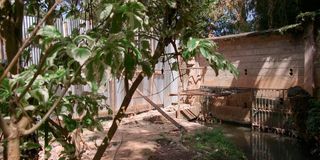
The wall that was marked for demolition by the National Environment Management Authority in 2017.
As the management of Jade Valley villas prepares for repairs and perhaps reconstruction of the walls brought down by the Kibagare River waters, many environmentalists question how the property is likely to withstand the next flooding, with the attendant dangers it poses to both humans and the environment.
Nema, which initiated the case against Sky Africa Holdings but lost on appeal, said through its spokesman Evans Nyabuto that it had let the matter rest.
As the river courses its way around the leafy suburbs, tests carried on the water from the borehole at Jade Valley villas returned perturbing results. It was found to contain high sulphite reducing anaerobes, an indication that it was possibly contaminated with fecal waste.
“They can cause stomach problems”, the results done by Cropnuts Laboratory Services indicate, noting that the same water contained high TVC (Total Viable Count), an indication of possible presence of bacteria that may harm human beings.

